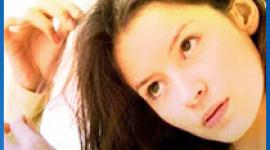Hair Pulling in Children: Trichotillomania

Hair pulling in children refers to a hair pulling disorder called trichotillomania in which the child feels a persistent, excessive urge to pull out his or her own hair. The practice results in obvious hair loss. Although it's common for children and teens to play with their hair, compulsive hair pulling in children can develop into a serious condition.
The Diagnostic and Statistical Manual for Mental Health, Fifth Edition (DSM-V), lists trichotillomania in children and adults in the chapter entitled, Obsessive-Compulsive and Related Disorders.
Physicians frequently classify hair pulling in children as simply a hair pulling habit; whereas, adolescent-onset trichotillomania typically indicates a more serious psychopathology.
Overview of Hair Pulling in Children
Hair pulling in children, or trichotillomania, usually begins in the preteen or adolescent years, but doctors have reported seeing the disorder in toddlers and young children. Although usually confined to hair on the head or face, children with the condition may pull hair on virtually any part of the body:
- Head
- Face (i.e. eyebrows and eyelashes)
- Arms and legs
- Pubic area
Experts don't have a clear understanding of what causes trichotillomania in children or adolescents, but theorize that a number of factors may contribute to the development of the condition:
- Genetic factors – children with a first degree relative with the disorder are more likely to develop it.
- Brain chemistry – research indicates that deficiencies of important brain chemicals (i.e. serotonin or dopamine) may contribute to the development of the condition
- Environmental factors – some experts believe traumatic events may trigger childhood or adolescent onset (i.e. abuse, death of loved one, drastic change in living conditions)
The signs and symptoms of trichotillomania in children include:
- Persistent, excessive pulling of one's hair that results in obvious hair loss
- A mounting sense of tension or anxiety directly before hair pulling or when trying to resist in compulsive hair pulling
- A rush of pleasure, relief, or gratification when hair is finally pulled out
- No other mental disorders or physical illness can account for the hair loss
- The condition results in significant impairment in social, educations, or employment activities
- The child or adolescent may or may not have an awareness that their behavior is abnormal and excessive
Doctors will diagnose hair pulling in children as trichotillomania if the child exhibits a recurring behavior of hair pulling that causes them considerable anxiety and distress. Prior to diagnosis, the doctor may conduct the following tests:
- Biopsy of the scalp or bald area to test for bacterial, viral, or fungal infections
- Tests for alopecia or spot baldness
- Other possible medical explanations for hair pulling and spot baldness
The primary focus for treating hair pulling in children involves psychotherapy approaches and, sometimes, medication. Doctors usually treat trichotillomania in children using cognitive behavioral therapy (CBT) techniques that help the child become self-aware of their pulling and the things that trigger it.
Once children understand and become aware of their habit, they can then begin habit reversal therapy. Some experts recommend that patients take measures to make hair pulling more challenging (i.e. wearing bandages around fingernails or wearing all hair under a hat). For more difficult cases, doctors may recommend a special type of CBT called exposure and response prevention therapy which works to expose the patient to triggers and then resist the urge to pull hair.
Especially with children and adolescents, medication isn't the first choice, but the doctor may prescribe antidepressants known as selective serotonin reuptake inhibitors (SSRIs) during the course of therapy.
APA Reference
Gluck, S.
(2022, January 10). Hair Pulling in Children: Trichotillomania, HealthyPlace. Retrieved
on 2025, April 19 from https://www.healthyplace.com/ocd-related-disorders/trichotillomania/hair-pulling-in-children-trichotillomania



